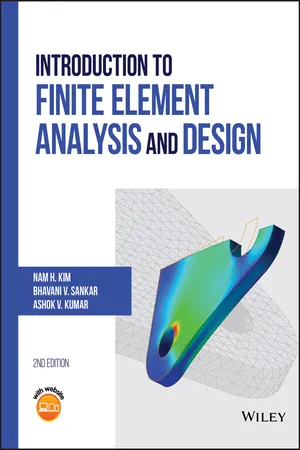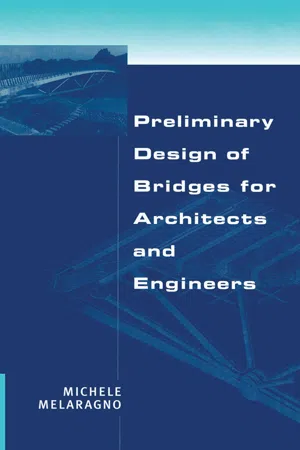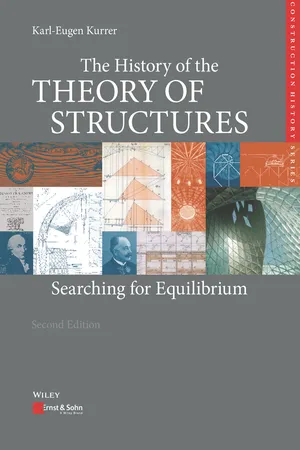Technology & Engineering
Structural Design
Structural design involves creating the framework and support systems for buildings, bridges, and other structures to ensure they are safe, stable, and durable. It encompasses the analysis, planning, and implementation of materials and components to withstand various forces and loads. This process integrates engineering principles and design aesthetics to achieve functional and visually appealing structures.
Written by Perlego with AI-assistance
Related key terms
3 Key excerpts on "Structural Design"
- Nam-Ho Kim, Bhavani V. Sankar, Ashok V. Kumar(Authors)
- 2018(Publication Date)
- Wiley(Publisher)
Chapter 10 Structural Design Using Finite Elements10.8 INTRODUCTION
Finite element analysis is concerned with determining the response (displacements and stresses) of a given structure for a given set of loads and boundary conditions. It is an analysis procedure in which the structural configuration—its geometry, material properties, boundary conditions and loads—is well defined, and the goal is to determine its response. On the other hand, engineering design is a process of synthesis in which parts are put together to build a structure that will perform a required set of functions satisfactorily. Analysis is very systematic and can be taught easily. Design is an intuitive and iterative process. Clearly, analysis is one of the several steps in the design process because we use analysis to evaluate the adequacy of the design. In this chapter, we will briefly discuss the basic steps in Structural Design and the use of finite element analysis (FEA) in the process of designing a structure.There are two general approaches to design: creative design and adaptive design. The former is concerned with creating a new structure or machine that does not exist, whereas the latter is concerned with modifying an existing design to perform better. Although analysis techniques such as FEA play a crucial role, the designer’s experience and creative ideas are important for the former. Adaptive design is an evolutionary process and is encountered much more frequently in practice. For example, how many times does an automotive company design a new car from scratch? The majority of engineers’ work concentrates on improving the existing vehicle so that the new car will be more comfortable, more durable, safer, and more fuel efficient. In this chapter, we will discuss the role of FEA in the adaptive design process.- Michele Melaragno(Author)
- 2021(Publication Date)
- CRC Press(Publisher)
Recently a more specific terminology emerged in this field: “structural morphology,” which refers to the expression of forms as a final representation of scientific concepts, technology, and aesthetics combined. An engineering structure, whether a building, bridge, dam, or industrial plant. Becomes an accomplished entity in itself that requires a proper identification within its overall personality that includes its functions. In other words, structural forms stand out on their own within the overall configuration of the whole.SEARCHING FOR ENGINEERING AESTHETICS
Well known engineering projects, in their typical programming format and their educational realm, have traditionally excluded concepts of aesthetics per se, leaving a vacuum in the education of young engineers. With the emphasis given to environmental concerns in the last few decades, any engineering structure is required to fit within the surrounding environment, both in the landscapes of the countryside as well as in the cityscapes of urban centers.To fill this vacuum, architects and environmentalists gradually have become involved with engineering projects. The team approach that results from this collaborative work, however, requires that engineers become knowledgeable to a certain extent in the overall art of designing so that efficient communication may be established between the team workers, starting with the usage of a common language that all understand. Naturally, it is impossible for major results to be accomplished in this context by a concentrated short course in basic design. However, the following are a few presentations made with the purpose of introducing a basic vocabulary concerning design in general.To begin, one could first introduce the idea that any structure built by man can acquire aesthetic values in itself and become harmonious with its surroundings when a designer succeeds in doing so either through intuition or through the application of basic design principles. The success of a structure is then assessed both by knowledgeable critics as well as by the public in general following different criteria. Many structures that are fashionable in one period may become totally obsolete and anachronistic years later when the social climate is changed. On the other hand, structures may survive the critics through long spans of time, retaining their original aesthetic values after centuries of service.- eBook - ePub
The History of the Theory of Structures
Searching for Equilibrium
- Karl-Eugen Kurrer, Philip Thrift(Authors)
- 2018(Publication Date)
- Ernst & Sohn(Publisher)
tekhnē. So the aesthetic component in the conceptual design work of the structural engineer also dwindled. Computational statics brought to a head the trend towards calculated building.Nevertheless, modern information and communications technology is today already indicating a systematic design practice that could enable the structural engineer to regain lost design competence and the architect to regain lost engineering competence, both on a higher level. For example, over 30 years ago, Ekkehard Ramm was already drawing attention to the visualisation and animation of mechanical relationships and processes; that would have been a decisive step towards the evolution of structures and loadbearing system synthesis [Ramm et al., 1987]. Another example might be the computer-aided display of engineering works [Klooster & Permantier, 1998]. A third way of departing from calculated building might be the creation of computer-aided graphical analysis, which could be placed in the phase transition between structural engineering studies and theory of structures (Fig. 14-10 ). It was in 1965 that Wolfgang Brennecke introduced the concept of “structural engineering studies” as a designation for the adequate treatment of loadbearing structures in architectural courses of study and staked out the area of study of this topic. He saw this as the fundamental treatment of the loadbearing elements within the subject of conceptual design [Brennecke, 1965, p. 660].Graphical treatment of a sheet metal crane after Culmann [Culmann, 1864/1866, plate 11]FIGURE 14 - 9Computer-aided graphical analysis must have a modular structure so that every individual construction in graphical statics, e. g. the funicular polygon, can be mobilised by the user in the form of specially developed graphic editors, displayed on the screen and coupled with other graphic editors to form defined constructions in the sense of graphical analysis. The use of such graphic editors and dimensioning modules based on approximation methods would enable the results of the graphical analysis synthesis to be transferred directly to the level of the loadbearing system. Computer-aided graphical analysis would be, so to speak, a hinge between conception and design because it goes beyond a pure morphology of the building fabric. And last but not least, at university level it would be a suitable means for bringing together students of structural engineering and architecture in the loadbearing system synthesis, as the virtual building would increasingly link the two professional groups in teaching, research and practice.
Index pages curate the most relevant extracts from our library of academic textbooks. They’ve been created using an in-house natural language model (NLM), each adding context and meaning to key research topics.


